I'm shocked shocked that the Lerners think like suburbanites...
Today's Post reports that the new Washington Nationals baseball team owners would rather have blighted parking structures above ground adjacent to the stadium rather than exciting ,vibrant streets and businesses (the article makes the point that the baseball team wouldn't share in the revenue from those spaces). From the article, "Owners Want City to Shift Gears on Parking":
The Washington Nationals' ownership group is pushing District officials to build massive parking garages for the baseball stadium aboveground, contrary to the wishes of city planners, who say the structures should go underground to make way for a potentially lucrative entertainment district.
The outcome of the negotiations, which could be decided in a few weeks, could drastically affect the look of the ballpark area in Southeast Washington and determine whether the city, which has committed $611 million in public money to the stadium, reaps as much tax revenue from related development as promised by Mayor Anthony A. Williams (D).
Here's my response:
1. This is Tyson's Corner Mall, owned by the Lerners. It typifies how they think about development and the centrality of the automobile rather than paying attention to outdoor spaces, public spaces, and walking-pedestrian oriented places.
 Washington Post Photograph by Tracy A. Woodward. Overview of the Tysons Corner area. Photo taken from the Tower Club at Tysons Corner. Looking west across Tysons Corner, over the Tysons Corner Shopping Center.
Washington Post Photograph by Tracy A. Woodward. Overview of the Tysons Corner area. Photo taken from the Tower Club at Tysons Corner. Looking west across Tysons Corner, over the Tysons Corner Shopping Center.2. Just because Ted Lerner grew up in the city doesn't mean that he or his family appreciate the urban experience. All the money they've made from real estate development has pretty much derived from the suburbs and automobile-centric development.
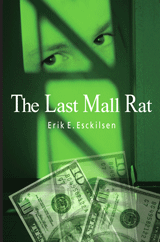
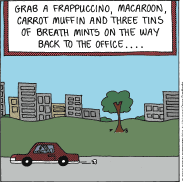 A frame from the comic Cathy.
A frame from the comic Cathy.3. While the city has agreed to pay for a stadium and wants to build an urban experience around it...
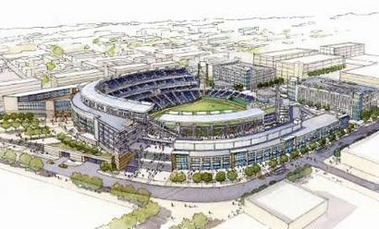 Drawing of the southeast view of a new baseball stadium unveiled by Mayor Anthony Williams, the D.C. Sports & Entertainment commission and the Washington Nationals during a news conference in Washington March 14, 2006. MANDATORY CREDIT REUTERS/HOK Sport/Devrouax & Purnell/Handout
Drawing of the southeast view of a new baseball stadium unveiled by Mayor Anthony Williams, the D.C. Sports & Entertainment commission and the Washington Nationals during a news conference in Washington March 14, 2006. MANDATORY CREDIT REUTERS/HOK Sport/Devrouax & Purnell/Handout 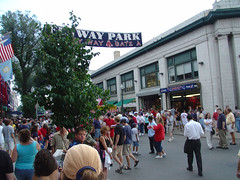 Yawkey Way, Boston. Flickr photo by Potami.
Yawkey Way, Boston. Flickr photo by Potami.4. This $611 million gift to the Lerners and to Major League Baseball is made possible by the District of Columbia and its taxpayers. (Rent will pay for a portion of the stadium, but only a portion. MLB doesn't even want to pay for upgrades to the subway station. They are lobbying their old friend, former Texas Rangers managing partner George W. Bush, to get the federal government to pay for it...)
5. The contract favors the Lerners, because the city didn't put in many provisions that favor the city, they pretty much yielded most everything to Major League Baseball. (One of my colleagues says this happened because Mayor Williams relied on the advice of people like Fred Malek, and people at the Sports and Entertainment Commission, who cared more about baseball and less about developing a somewhat equal relationship between the city and Major League Baseball.)
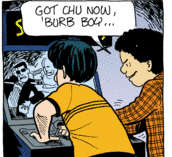 Frame from Crankshaft where the city boy appears to be defeating the suburban kid in a videogame.
Frame from Crankshaft where the city boy appears to be defeating the suburban kid in a videogame.5. Bad contracts make for unequal negotiating. But in any case, I think the city should play "hardball" on this particular issue. It matters too much to making a great place out of the Stadium District.
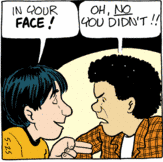 Frame from Crankshaft, where the suburban boy ends up "schooling" the city boy.
Frame from Crankshaft, where the suburban boy ends up "schooling" the city boy.6. Great outdoor places aren't really anything that the Lerners know too much about.
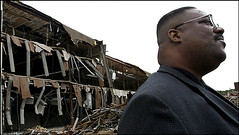 "The baggage and ghost of Landover Mall still negatively impact us today," says activist Arthur A. Turner Jr. of the Lerner Enterprises complex. Photo Credit: By Lois Raimondo, The Washington Post. (From "Mall's Comedown Taints Lerner Image: Resentment of Nats' New Owner Lingers in Pr. George's")
"The baggage and ghost of Landover Mall still negatively impact us today," says activist Arthur A. Turner Jr. of the Lerner Enterprises complex. Photo Credit: By Lois Raimondo, The Washington Post. (From "Mall's Comedown Taints Lerner Image: Resentment of Nats' New Owner Lingers in Pr. George's")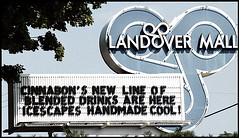 Retail shops have foundered near Fed-Ex Field. Landover Mall closed in 2002. Photo By Marie Poirier Marzi For The Washington Post, 1999.
Retail shops have foundered near Fed-Ex Field. Landover Mall closed in 2002. Photo By Marie Poirier Marzi For The Washington Post, 1999.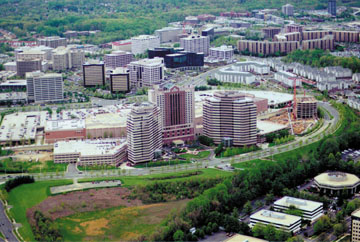 Tysons Corner, Virginia, aerial view.
Tysons Corner, Virginia, aerial view.Index Keywords: stadiums-arenas; car-culture; urban-design-placemaking



0 Comments:
Post a Comment
<< Home